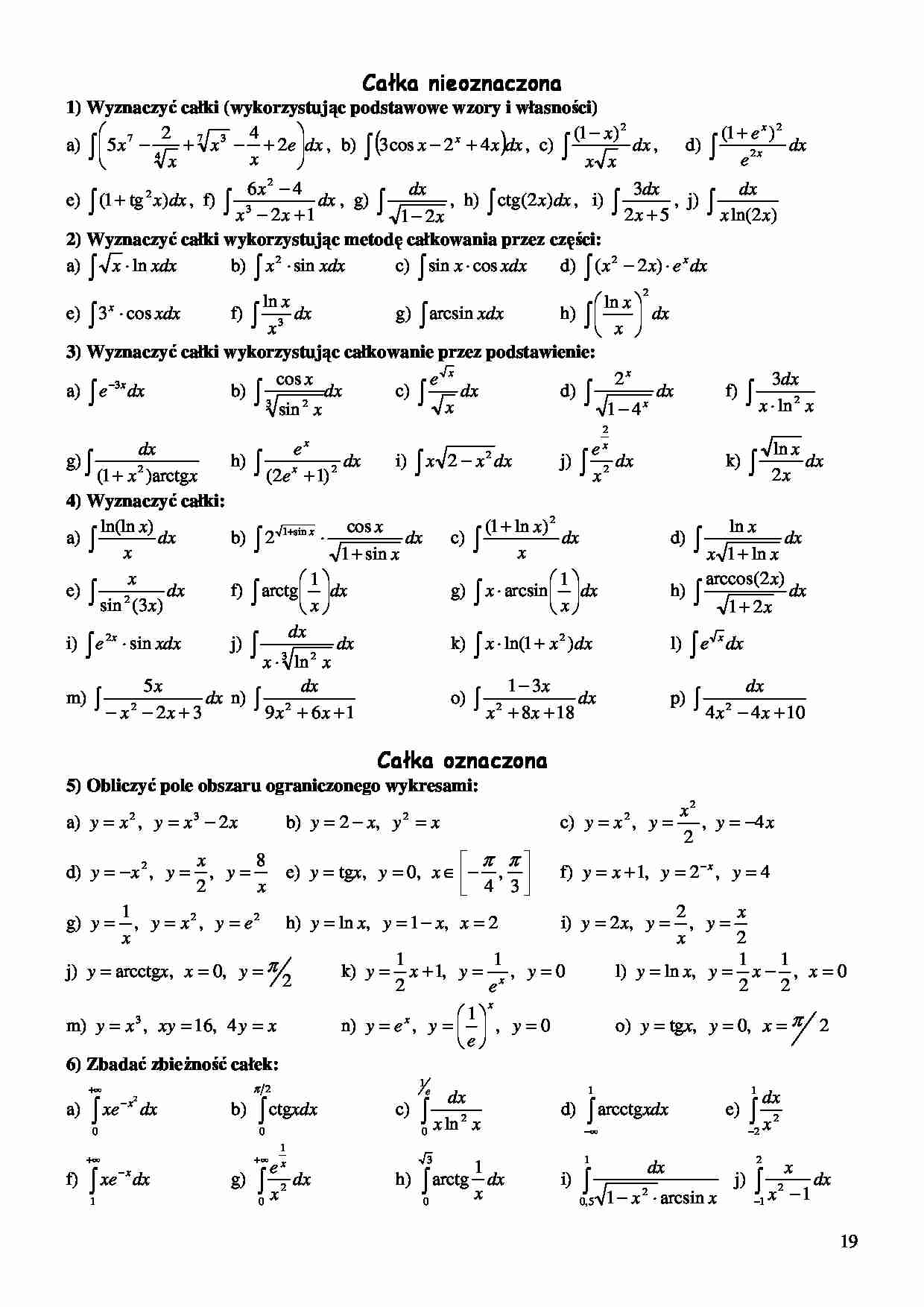
Całka nieoznaczona 1) Wyznaczyć całki (wykorzystując podstawowe wzory i własności) 1 ( x 2 ) 1 ( e x 2 ) 7 2 7 3 4 a) ∫ 5 x − + x − + 2 e dx , b) ∫(3cos x − x 2 + 4 x ) dx , c) ∫ − dx , d) ∫ + dx 4 x x x x e 2 x 6 x 2 − 4 dx 3 dx dx e) ∫ 1 ( + tg 2 x ) dx , f) ∫ dx , g) ∫ , h) ∫ ctg(2 x ) dx , i) ∫ , j) ∫ x 3 − 2 x + 1 1 − 2 x 2 x + 5 x ln(2 x ) 2) Wyznaczyć całki wykorzystując metodę całkowania przez części: a) ∫ x ⋅ ln xdx b) ∫ x 2 ⋅ sin xdx c) ∫ sin x ⋅ cos xdx d) ∫ ( x 2 − 2 x ⋅ ex ) dx 2 ln x ln x e) ∫ x 3 ⋅ cos xdx f) ∫ dx g) ∫ arcsin xdx h) ∫ dx x 3 x 3) Wyznaczyć całki wykorzystując całkowanie przez podstawienie: cos x e x x 2 d 3 x a) ∫ − e 3 x dx b) ∫ dx c) ∫ dx d) ∫ dx f) ∫ 3 2 2 sin x x 1 − x 4 x ⋅ ln x 2 dx e x e x ln x g) ∫ h) ∫ dx i) ∫ x − x 2 2 dx j) ∫ dx k) ∫ dx 1 ( + x 2 )arctg x (2 e x + 2 ) 1 x 2 2 x 4) Wyznaczyć całki: ln(ln x ) 1 ( ln x 2 ) ln x 1 cos x x a) ∫ dx b) ∫ + 2 sin ⋅ dx c) ∫ + dx d) ∫ dx x 1 + sin x x x 1 + ln x x 1 1 arccos(2 x ) e) ∫ dx f) ∫ arctg dx g) ∫ x ⋅ arcsin dx h) ∫ dx sin 2 3 ( x ) x x 1 + 2 x dx i) ∫ e 2 x ⋅ sin xdx j) ∫ dx k) ∫ x ⋅ ln 1 ( + x 2 ) dx l) ∫ e x dx x ⋅ 3 2 ln x 5 x dx 1 − 3 x dx m) ∫ dx n) ∫ o) ∫ dx p) ∫ − x 2 − 2 x + 3 9 2 x + 6 x + 1 x 2 + 8 x + 18 4 2 x − 4 x + 10 Całka oznaczona 5) Obliczyć pole obszaru ograniczonego wykresami: 2 x 2 a) y = x 2 , y = x 3 − 2 x b) y = 2 − x y 2 , = x c) y = x , y = , y = 4 − x 2 π π 2 x 8 d) y = − x , y = , y = e) y = tg x , y = , 0 x ∈ − x − , f) y = x + , 1 y = 2 , y = 4 2 x 4 3 1 2 x g) 2 2 y = , y = x , y = e h) y = ln x , y = 1 − x , x = 2 i) y = 2 x , y = , y = x x 2 1 1 1 1 j) y = arcctg x , x = ,
... zobacz całą notatkę



Komentarze użytkowników (0)